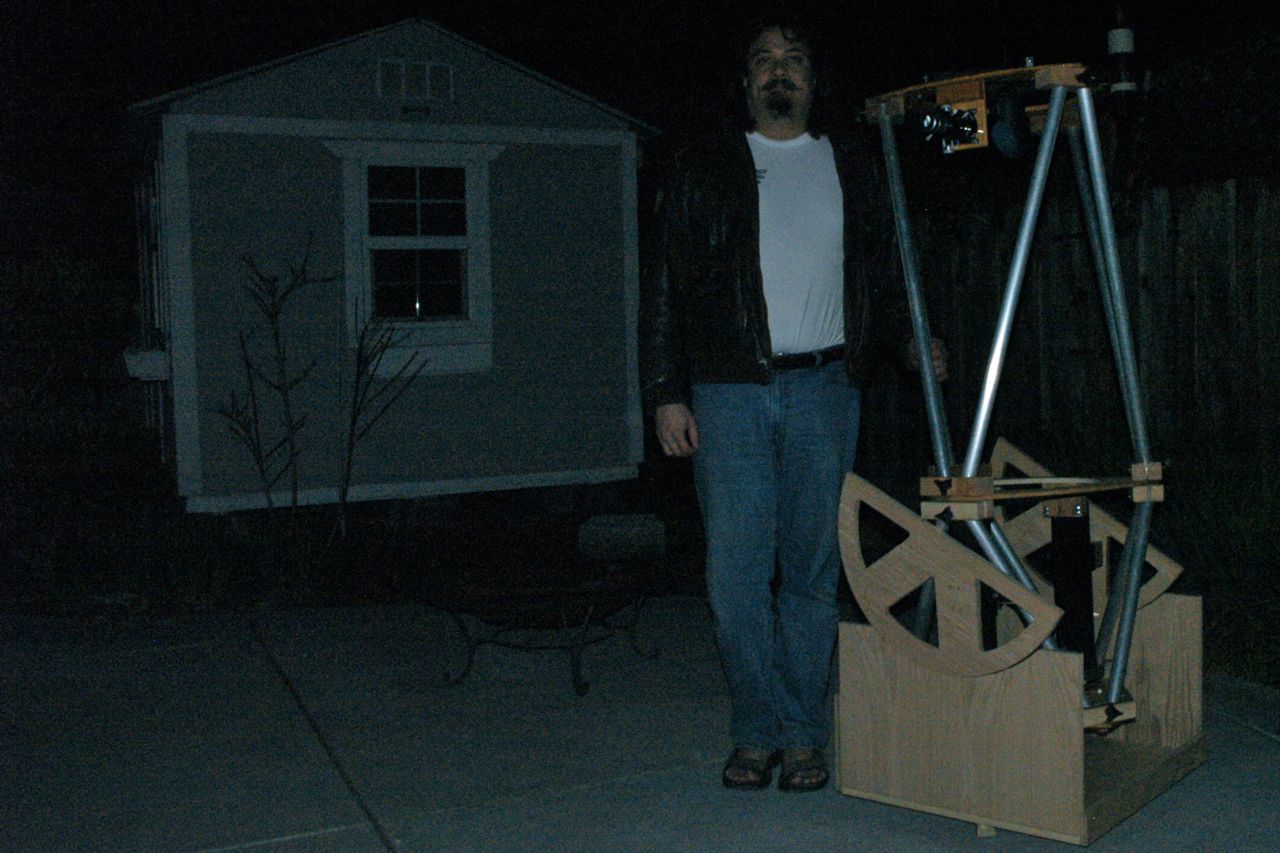Well, nobody can say I didn’t pay my dues on this one. Between weeks of rain and countless trips to the hardware store, I think I earned myself a little starlight.
After causing the first snowstorm in San Francisco since 1976 (hey, I was here for that one, too… hmm…), I finished up the Dobsonian mount today, just in time for the only clear night we’re going to have for awhile. Nice!
I was shoring up the rocker box right up until dinnertime, and took everything outside after dinner to find gorgeous clear sky from horizon to horizon.
First, an observing report. Then, a report card on the scope and mount. Before I get started, here’s a pretty goofy photo of scope and builder, best I could do outside in the dark.
On with the show.
After some unsuccessful attempts to find things without a finderscope (there are no straight lines on this telescope that one can use for visual cues as to where you’re pointing…), I attached a finder, spent 15 minutes trying to find a bright enough star to center in both scopes (Rigel ended up being the one; you can stumble around in Orion until you find something bright), and I was off to the races.
First up, I don’t know if I’ve had a scope where the first light didn’t include it, was The Great Orion Nebula. It filled the 1.25° field of view (I was using the 32mm Highlight Plossl, my favorite eyepiece) with bright grey nebulosity. I could see the “head” of the “bird”, and the dark patch leading down to the Trapezium, which centered a really big pool of cloudy goodness.
I moved over to The Pleiades, which spilled out of the FOV. The diffraction spikes look pretty sharp, even at low power. Nice.
From there, I decided to try an object that I don’t think I’ve ever looked at visually before, M1 The Crab Nebula. I pulled out my star chart, pointed the scope, and there it was. Oh, it’s dim. No question. But it was definitely there, I could see its oval shape drifting across the field slowly. This 13″ scope pulls in some photons.
M35 was very nice; I can’t tell if I picked up its little buddy (2158?) off to one side, or if that’s just part of M35. M44 was awesome, with big orange stars sprinkled among the little blue ones.
I looked for M65/66 a couple of times, but never found them; dark adaptation and a mirror that was picking up light from the TV conspired against me.
I pointed over to M81/82, and found them on the first try. Wow. M82’s cigar always looks cooler visually, there was a little star like a spark halfway between the bulge and one tip of the galaxy. M81 had a brighter core than M82, but mostly just faded to a round ball of fuzz.
M51 and M101 were still behind the house from my vantage point. I tried M97, M109, M63, but my starhopping skills need a lot of work.
I was able to easily split Pollux (I assume the little baby star off to one side is its double). Castor, no. Capella, no. Polaris, no. I enjoyed how easy it was to look at Polaris. Saw the diamond ring for the first time. I saw M37 (M38?) visually, it looked *really* cool at the eyepiece, a couple dozen little teeny stars sprinkled with even smaller ones.
Now I started looking for photographic nebula targets. I pointed at the Horsehead, not expecting to see anything. Zeta Orionis was doing its best to kill my dark adaptation, but I saw what I assume is the Flame Nebula. I pointed at the Rosette, and found the central cluster, thought I wasn’t seeing nebulosity, then realized that the whole field was nebulosity. I realized this when I started moving around and saw a “brighter knot” of nebula, then pushed further afield and noticed the sky background was suddenly a little darker. I still can’t say that I “saw” The Rosette, other than that bright patch, but wow. I then moved over to the Christmas Tree Cluster. That was … spectacular. The asterism barely fit in the FOV. And, around the bright “star” at the top of the tree, I definitely saw a “C” shaped chunk of nebular cloud. I know the cone is in there somewhere, but I’m not a good enough observer to know which direction it was coming from.
I did a little more poking around, then decided that I was getting tired and should pack it up. As I was preparing to move, though, I noticed that a fairly bright star had popped above the horizon over in the Arcturus/Spica/Denebola area of sky, and I decided it was worth moving the scope to investigate. I’m glad I did, because the “star” turned out to be Saturn. Awesome! The rings are really starting to open up again right now, and Titan was looking good. I got some practice with the nudge-nudge while trying to bump the magnification and watch the planet drift across the field. A very nice end to the evening.
I packed the eyepieces and scope up and came inside.
Report card time.
As for the scope itself, it performed as well as I could have wanted. Although I didn’t collimate before viewing, I felt like the scope was close enough to collimation that I got a decent look at the optics. Diffraction spikes were sharp; focus band was a bit tight, but that’s f/5 for you. When the house lights were off, the scope performed marvelously. The structure felt very solid. It could use collimation, and I had to pull the parfocalizing rings off the eyepieces, but every eyepiece combination I tried came to focus. I really need a light baffle, although I think shooting in the observatory will help a bit. I had to quit when the mirrors started fogging up; I think the secondary was going pretty bad, but I don’t think the primary had started yet. The scope weighs a ton.
Now for the mount. Overall, it was a good first experience with a Dob, but I have work to do. Among things I like, the azimuth motion is buttery smooth. Feels very nice. Also, I did not have to use any counterweight, even with my heaviest eyepiece. The scope stayed where I put it. I moved the scope a couple of times during the night, and while it’s not something that I would want to do all the time, it was definitely pretty easy. Both the mount and the OTA have feet now, and so I was able to pick stuff up and put it down without scuffing anything.
The bad part about the mount, and it’s a big and constant problem, is that the altitude bearings are really not working well. I had to take out the sliders, because they were rounded and driving me batty. So the wood-on-wood motion is a little sticky and also a little wobbly (it wobbles up and down in altitude because of the (as-designed) different radii of the rocker and bearing. I need to get bearing sliders in there. Another problem with the bearings is that the spacers I put in are just slightly too wide, which means that I had to be constantly careful not to let the scope fall off of one bearing or the other. It actually “popped off the rails” at once point, luckily, I was able to catch it and put it back in place. Scary. Also, I’m not 100% certain the bearings are parallel. I need to shim-and-trim the spacers to get everything right.
In the final analysis, the constant fear of losing the OTA due to a bearing slippage made the whole experience a little more stressful than I really wanted. I will look in The Book and online and do some head scratching/soul searching to figure out how to fix the problem. The Dob setup is really, really close to being just heavenly. I just need to work out the bugs.
Amazing, incredible, awesome first light.



Awww…aren’t the two of you a cute couple.